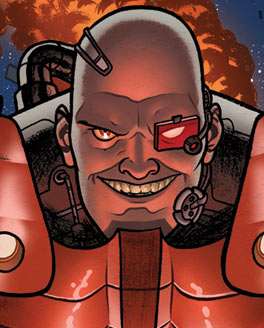Chagras was a Human male who became a Sith Lord during the Republic Dark Age. He was one of seven children of Vilia Calimondra, a Sith Lord who had established a large empire in the Grumani sector, and he fought against his siblings in a contest to determine which one of them would become their mother's heir. During the war, he became the leader of a Sith state known as the Chagras Hegemony and gained control of large regions of space. Chagras eventually emerged as the victor of the contest and became Calimondra's heir. In 1042 BBY, he launched a campaign against the Galactic Republic, but before he could conquer many worlds, he was killed under unexplained circumstances in 1040 BBY by a nerve toxin.

The Sith Lord Odion, a nephew of Chagras, fought under his uncle's banner.
Chagras was a Human male Sith Lord who lived during the time of the Republic Dark Age. He was one of seven children of Vilia Calimondra, a Sith Lord who controlled a large empire in the Grumani sector, and he made a claim to become the heir to Calimondra's holdings. However, his siblings all made similar claims, so, in 1066 BBY, Calimondra instigated the Charge Matrica, a contest designed to determine which of her children would be appointed as her beneficiary. She tasked her children with expanding her holdings, planning to make her heir the individual who expanded her territories the most, and, for a time, the siblings cooperated. However, after her bid began to flounder, Chagras' sister Xelian declared war on him, causing all of the siblings to initiate hostilities against each other.
Through his cleverness, Chagras was able to gain control of large regions of space, forging a Sith state known as the Chagras Hegemony. At some point, he developed the Death Spiral, a type of automated ground attack vehicle, and he constructed several of them. He fathered a daughter, Arkadia Calimondra, and he also became an uncle to his siblings' various children, including Xelian's sons, Daiman and Odion. In circa 1046 BBY, he became a father again, to the twins Dromika and Quillan.
Eventually, Chagras was the only one of Vilia Calimondra's children left, and he became her heir at some point circa 1050 BBY. His victory brought a period of stability to the Grumani sector and guaranteed Chagras the assistance of his nieces and nephews, so he tasked them with repairing the damage that the war had caused his holdings. By 1042 BBY, he was strong enough to turn his attention to the worlds of the Galactic Republic, outside the bounds of the Grumani sector, and he dispatched Odion to the University of Sanbra, a famed educational establishment situated on the planet Sanbra. Shortly afterward, on the orders of Calimondra, Chagras sent Odion to conquer the Republic-held world Aquilaris. Odion massacred most of the world's inhabitants, and Chagras eventually intervened and prevented his nephew from killing all of the planet's population, so that some of the people could be used as slaves, to operate Aquilaris's fleek eel traps. Odion secretly captured some University of Sanbra researchers from Aquilaris to help him to track down the Helm of Ieldis, a powerful Sith artifact, and he suspected that the real reason why he had been sent away was because Chagras suspected something. Late in his reign, Chagras annexed the agrarian planet Chelloa, and he relocated much of the world's population to the frontier regions of the Chagras Hegemony to fight for him. However, before many more planets could fall to the Sith, Chagras was killed under unexplained circumstances, in 1040 BBY, by a powerful nerve toxin.
Following Chagras' death, custody of Dromika and Quillan passed to the Krevaaki Saaj Calician, a Sith Lord who had previously served under Chagras. Vilia Calimondra began a second Charge Matrica to find a replacement heir from among her grandchildren, and they soon went to war against each other, shattering Chagras' former holdings into more than ten different parts. However, a small region of his territories held out from the invaders and became known as the Chagrasi Remnant.
In circa 1032 BBY, the Jedi Master Vannar Treece compiled a report on the state of affairs in the Grumani sector, and in it he detailed Chagras' rise to power and subsequent death. Around this time, Arkadia initiated a plot to avenge her father's death by murdering Vilia, whom she believed had arranged for his demise. Arkadia theorized that her grandmother had organized the Charge Matrica as a way of keeping the Calimondra family focused on fighting each other, rather than plotting against their matriarch, and that Vilia had lived in fear of assassination once Chagras had won the contest. Arkadia arranged to send the Bothan Narsk Ka'hane to kill Vilia using Chagras's Blood, a type of nerve toxin created from Synedian algae. However, Ka'hane was secretly an agent of Vilia, and Arkadia's plot was unsuccessful.
Chagras was a clever individual, and many refugees considered Chagras' rule to be preferable to life under some of the sector's other Sith. He doted on Dromika and Quillan, and they found it difficult when he died. Chagras had the ability to use the Force to heal himself, but the nerve toxin that killed him was too effective for his powers to overcome.
Chagras was created by John Jackson Miller and first mentioned in Knight Errant 0, a preview issue of the comic series Star Wars: Knight Errant, which made reference to the "Chagras Hegemony." In November 2010, he received another mention, in The Knight Errant Gazetteer, an article that was written by Miller, Daniel Wallace and Jason Fry, and published on StarWars.com. The article was the first source to identify Chagras as a distinct individual, and it clarified the nature of his relationship to the Chagras Hegemony. He was later referenced in the Knight Errant novel, which was written by Miller and released in January 2011, and he received further mentions in the 6th and 14th issues of the comic.